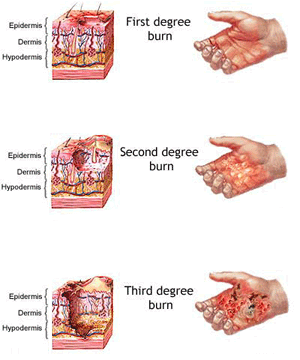First Aid – Burns
Burns may be classified according to extent and depth of damage as follows:
First degree – Minor
- The burned area is painful.
- The outer skin is reddened.
- Slight swelling is present.

Second degree – Moderate
- The burned area is painful.
- The underskin is affected.
- Blisters may form.
- The area may have a wet, shiny appearance because of exposed tissue.
Third degree – Critical
- Insensitive due to the destruction of nerve endings.
- Skin is destroyed.
- Muscle tissues and bone underneath may be damaged.
- The area may be charred, white, or grayish in color.
Burns may also be classified according to cause. The four major types of burns by cause are as follows:
- Chemical
- Thermal
- Electrical
- Radiation
The seriousness of a burn or scald is influenced by the extent of the body surface involved, as well as by the depth to which the tissues are penetrated. Burns can do more damage than injure the skin. Burns can damage muscles, bones, nerves, and blood vessels. The eyes can be burned beyond repair. The respiratory system structures can be damaged, with possible airway obstruction, respiratory failure, and respiratory arrest. Shock is very severe when burns are extensive and may cause death in a few hours.
First Aid for Burns
The first aid given to a burn victim largely depends on the cause of the burn and the degree of severity. Emergency first aid for burns or scalds should primarily be exclusion of air from the burned area, relief of the pain that immediately follows burns, minimizing the onset of shock, and the prevention of infection.
Remove all clothing from the injured area, but cut around any clothing that adheres to the skin and leave it in place. Keep the patient covered, except the injured part, since there is a tendency to chill. First aid dressings for burns and scalds should be free of grease or oil. The use of greases or oils in the treatment of burns makes it necessary to cleanse the burned or scalded areas with a solvent before medical treatment can begin. This delays the medical treatment and is very painful.
Be careful when dressing burns and scalds. Burned and scalded surfaces are subject to infection the same as open wounds and require the same care to prevent infection. Bandages should be loose enough to prevent pressure on burned surfaces. As swelling often takes place after burn dressings have been applied, check them frequently to see that they are not too tight. Watch for evidence of shock and treat if it is present. In cases of severe burns, transport the victim to the hospital as quickly as possible.
Burns of the Eyes by Chemicals
Frequently chemical substances, especially lime, cement, caustic soda, or acids or alkalis from storage batteries get into the eyes. The treatment is to wash the eyes freely with clean water. To do this, have the victim lie down, hold the eyelids open with the fingers and pour the water into the inner corner of the eyes from a pitcher or other container. Use plenty of water and wash the eyes thoroughly, being sure the water actually flows across the eyes. Do not put neutralizing solution in the eyes. Cover both eyes with moistened sterile gauze pads and secure in place. Chemical burns of the eyes should receive the attention of an eye specialist as soon as possible.
Chemical Burns
General first aid for chemical burns is as follows:
- Remove all clothing containing the chemical agent.
- Do not use any neutralizing solution, unless recommended by a physician.
- Irrigate with water for at least 15 minutes, use potable water if possible.
- Treat for shock.
- Transport to a medical facility.
First aid for dry chemical (alkali) burns is an exception to the general first aid for chemical burns because mixing water with dry alkali creates a corrosive substance. The dry alkali should be brushed from the skin and water should then be used in very large amounts.
Thermal Burns (Minor)
General first aid for minor thermal burns is as follows:
- Use cool, moist applications of gauze or bandage material to minimize blistering.
- Treat for physical shock.
If the victim has thermal burns on the eyelids, apply moist, sterile gauze pads to both eyes and secure in place.
Thermal Burns (Moderate and Critical)
General first aid for more serious thermal burns is as follows:
- Do not use cold applications on extensive burns; cold could result in chilling.
- Cover the burn with a clean, dry dressing.
- Treat for shock.
- Transport to a medical facility.
Electrical Burns
General first aid for electrical burns is as follows:
- Conduct a primary survey, as cardiac and respiratory arrest can occur in cases of electrical burns.
- Check for points of entry and exit of current.
- Cover burned surface with a clean dressing.
- Splint all fractures. (Violent muscle contractions caused by the electricity may result in fractures.)
- Treat for physical shock.
- Transport to a medical facility.
Respiratory failure and cardiac arrest are the major problems caused by electrical shock and NOT the burn. Monitor pulse and breathing while preparing victim for transportation.
Radiation Burns
Radiation presents a hazard to the rescuer as well as the victim. A rescuer who must enter a radioactive area should stay for as short a time as possible. Radiation is undetectable by the human senses and the rescuer, while attempting to aid the victim, may receive a fatal dose of radiation without realizing it. Notify experts immediately of possible radioactive materials contamination.